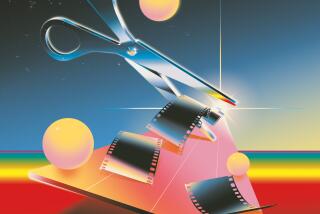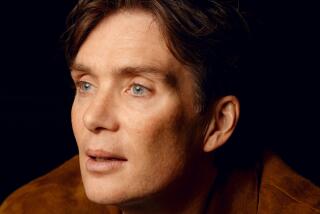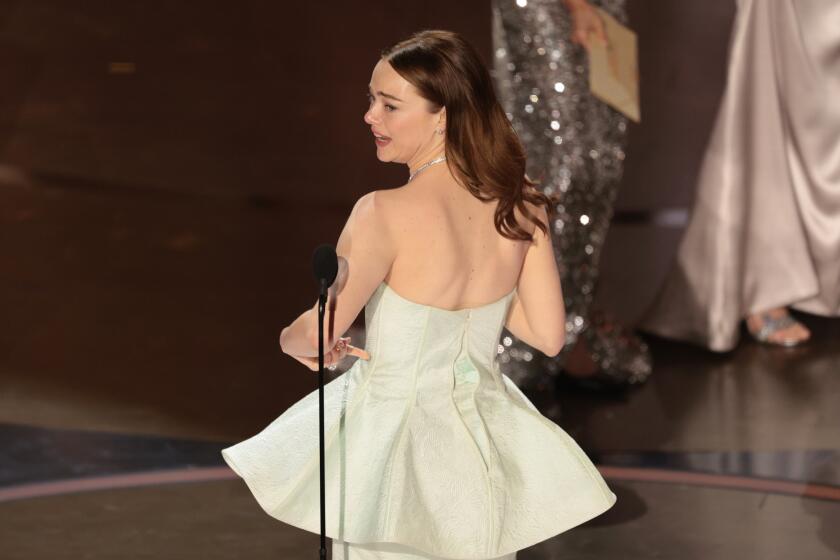The view from behind the lens: Four cinematographers pick their favorite shots
Most people, especially in this town, can tell you their favorite shot from a beloved film. We posed the question to the image makers themselves, asking cinematographers from this year’s seasonally expanding slate of noteworthy films to break down their favorite shots and describe how they made them work.
Rodrigo Prieto
“The Irishman” (Netflix)
directed by Martin Scorsese
“The Irishman” took 90 days to prep and 108 days to film, on film stock and with a VFX-ready digital camera rig, in 117 locations. To render what he calls Scorsese’s precise cinematic language across 309 scenes and a 50-year narrative, Prieto shot many of the ensemble scenes with up to three cameras simultaneously. That also let him shoot the leads with enough coverage for the VFX team at Industrial Light and Magic to gradually transform the actors, all in their mid-to-late 70s, into younger versions of themselves in postproduction without using motion-capture gear that might affect their performances.
Favorite scene: “One of my favorites is a scene toward the end of the film, where Frank Sheeran [De Niro] is watching his car being washed. This car is the reason he finally went to jail, on a technicality, which is kind of ridiculous after all the things he did in his life. His voice-over explains what the car has meant to him.”
Genesis of the shot: “The way Scorsese designed the scene was Frank watching from a little hallway through a window as his car is being washed. We shot the car with a Phantom camera to see how the tendrils of the carwash were caressing the car. Then De Niro said, ‘You know what, Marty? I always imagined myself inside the car during that scene.’
Making it work: “We had already done the shot of him looking at the car, and we needed to move to the next location and didn’t have much time. But Scorsese said to Bob, ‘Sure, get in the car and we’ll do a shot of that.’ So we put the Arricam, our primary film camera, on a dolly and followed him as the car moves through the carwash. Even though we had to execute it very quickly — the opposite of all the de-aged scenes with the Helium rig — it’s still one of my favorite shots. I had to improvise some lights on the side of the car so we could actually see his face. I love the way the water and the soap move through the glass in slow motion and his expression, now that he has finally realized things are falling apart. It’s a very emotional moment and really encapsulates the entire film. Scorsese used both shots: You see him looking at the car and then he’s in it, which was brilliant.”
Natasha Braier
“Honey Boy” (Amazon Studios)
directed by Alma Har’el
Shia LaBeouf’s deeply personal story about his childhood, which he wrote during rehab, is full of emotionally loaded visual surprises. Braier (“The Neon Demon”) adopted Har’el’s favored documentary-style shooting to capture the shifting emotional temperature on set and give LaBeouf the space he needed to relive traumatic periods from his past. She used a network of wireless LED lighting that she could dim and turn on as needed, following the actors where the story took them.
Favorite scene: “My favorite is the presentation of Otis as a child. We wanted to illustrate visually the essence of this character in a poetic yet pretty graphic and almost conceptual way.”
Genesis of the shot: “We used two shots that we meticulously designed and choreographed. The first one opens on Otis’ close-up in a black space looking straight at the camera. After a while, a pie in slow-motion crashes into his face. Straightaway there is violence and trauma. The impact sends him flying in the air away from us, and we see that he is hanging on wires like a puppet, a concept we will repeat in the presentation of adult Otis in the ‘Transformers’ shot. As the ‘puppet’ flies away from us in a sea of darkness, the lights behind him turn on, and we reveal he inhabits a TV set, where instead of a real home, he has a fake, painted-house background behind him. Nothing is real, which is something he will say to his dad at the end of the movie.”
Making it work: “We tested the rig beforehand, as well as different pie-throwing techniques and different types of pies and plates. We shot it high speed on a Phantom camera and rehearsed a few times to get the timing right for the lights to come on and reveal the set at the right moment. The challenge was actually to get enough light on the sensor in order to shoot high speed, since we couldn’t afford a lot of big lights on the show. I also love the shot that comes right after, where we present the father. We follow Otis backstage, mostly over the shoulder, establishing our emotional commitment to the character at the same time reinforcing the ‘puppet’ harness, and continuing to play graphically with this idea of a blurry line between reality and representation.”
Mihai Malaimare Jr.
“Jojo Rabbit” (Fox Searchlight)
directed by Taika Waititi
In a coming-of-age story about a Hitler Youth that is equal parts “Life Is Beautiful” and Monty Python, “Jojo Rabbit” addresses its serious subject head on through the wide, impressionable eyes of its 10-year-old protagonist (Roman Griffin Davis). After discovering the Jewish teen his mother is hiding in the attic, Jojo’s relationships with reality and with his imaginary friend, Adolf Hitler, begin to shift dramatically. Waititi delivers the dictator with an unhinged zaniness even Chaplin and John Cleese would admire.
Favorite scene: “I love the scenes we shot inside Elsa’s [Thomasin McKenzie] hiding place in the small attic adjacent to Inga’s bedroom, a particularly challenging location. But having the luxury of building the set allowed us to make it fit our needs perfectly.”
Genesis of the shot: “I remember long discussions about what the light source would be inside the space and how to show the time of day. We made some vent holes at the edge of the roof that allowed us to have some daylight come through. We all agreed that during nighttime, Elsa would have a candle or a petrol lamp. That immediately made me think of ‘Barry Lyndon’ and how amazing it would be to try to use a candle or a petrol lamp as the main light source.”
Making it work: “We used mainly anamorphic 1.3x lenses, but we specifically carried a set of Vantage One T1 spherical lenses to help us with the two night scenes between Rosie [Jojo’s mother, played by Scarlett Johansson] and Elsa in the hiding place. The T1 wide aperture allowed us to shoot using only a candle or petrol lamp as a key light.
“Taika likes to improvise a lot, but he is a very collaborative person. Our approach for most of the scenes was: rehearse, block and shoot; we only storyboarded the battle scenes. That gave the actors a lot of freedom but also gave us the opportunity to observe and get lots of ideas from them. Shooting wide open at T1.0 can be very challenging for focus, especially when you want to give the actors freedom of movement. The hiding place was pretty small, so I knew they will be limited in their movement and the light source would have to be pretty close to the actors. It all turned out great.”
Jörg Widmer
“A Hidden Life” (Fox Searchlight)
directed by Terrence Malick
This is Widmer’s first Malick film as cinematographer, although he has worked on the director’s last five films as a Steadicam operator for director of photography Emmanuel “Chivo” Lubezki. In Malick’s latest, Widmer kept the cameras constantly rolling along the breathtaking yet steep and sometimes stormy mountain locations to give the actors plenty of room to improvise. Malick and Widmer used the weather and practical light whenever possible to inform their choices, and thunderstorms, high winds and snowfall all played a part. The film’s sweeping, unrelenting deep focus during the outside scenes makes the landscape as much a silent witness to the couple’s suffering as a backdrop.
Favorite scene: “I love the entire film. While making the movie with Terrence and the crew, the camera tried to serve the storytelling and didn’t look for eye-catching highlights. There is an apparent simplicity in the way we captured the scenes. The last meeting of the couple, Franz and Fani Jägerstätter, before Franz is executed, is a great example of what we did throughout the film.”
Genesis of the shot: “This scene follows the script.
Malick, however, likes to give actors a maximum of space and freedom, letting them play within the given field. Franz Jägerstätter, farmer and father of three children, refused to swear loyalty to Hitler and fight for the Third Reich in World War II. As a result, he has been sentenced to death. Leading into this scene, Fani comes to visit him accompanied by their village priest, and they anxiously wait in the visitors room. At last, Franz enters, and the husband and wife see each other for the first time in months. Full of joy and intense emotion, they try to hug and kiss but are immediately separated by the wardens who brutally shove them into separate chairs. Franz and Fani are allowed to speak to each other only across the table, forbidden a chance for further physical endearment. We see the defense counsel trying to convince Franz to sign a paper that would allow him to avoid the death penalty. The priest joins in, encouraging Franz to sign. Fani, knowing that this goes against Franz’s unwavering conscience, makes no attempt to force him. Instead, she shows him affection, knowing he will not buckle.
Making it work: “We used the natural light as much as possible, shooting at the best time of day. The smooth camera movements on a slider mixed with handheld builds up an unbearable tension. Franz hardly speaks. In his close-up you see the mix of pain, suffering and affection in his face. When Franz asks Fani if she understands, you can read in her eyes that her love is paramount. Her pain, when Franz is led away, is heartbreaking.”
More to Read
Only good movies
Get the Indie Focus newsletter, Mark Olsen's weekly guide to the world of cinema.
You may occasionally receive promotional content from the Los Angeles Times.






